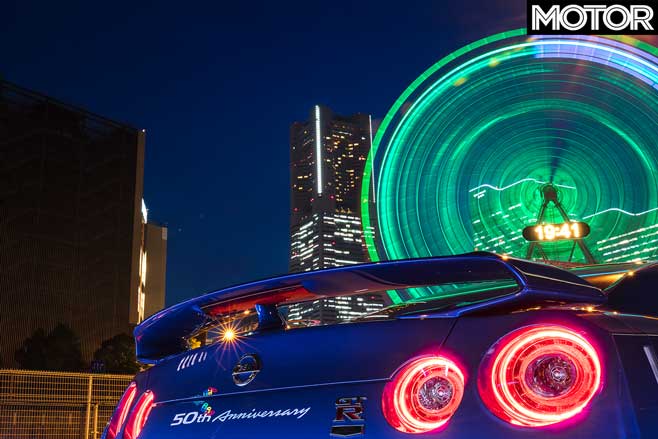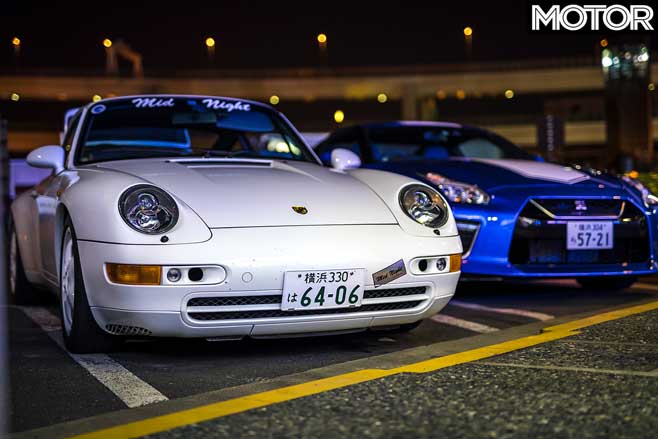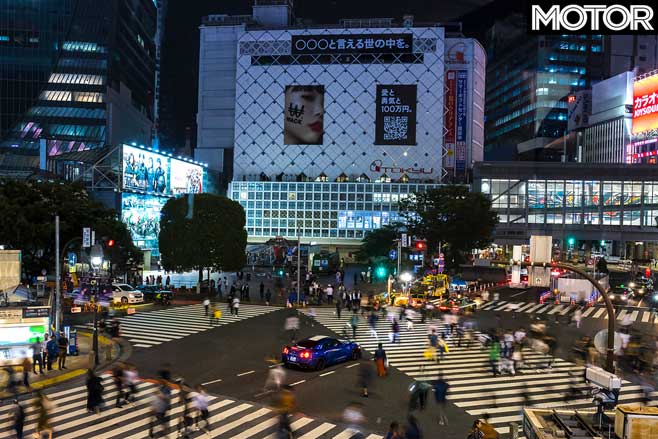Kanagawa, Japan. I’m deep in the bowels of a Tokyo Police Station, wondering quite what the hell I’m doing here. It’s taken 45 minutes, so far, to pay a parking fine that took all of five minutes to receive. And as I sit here, alone, in some random quiet corridor in this labyrinthine building, I can’t help but wonder if I’m about to become a diplomatic incident.
It’s somewhat ironic, too, that I should find myself in trouble with the law for this most minor of indiscretions, given the last 24 hours I’ve had. I’ve been hot on the tail of the mysterious Mid Night Club, the exclusive and secret clique of street racers that streaked across Tokyo’s public expressways at speeds of more than 300km/h, in the ’80s and ’90s.

No retelling of the story of Nissan GT-R would be complete without delving into its starring role in this most infamous of underground street racing scenes. Formed in 1982, the Mid Night Club, or Mid Night Racing Team, would meet, as its name suggests, in the middle of the night, and host full-blown races up the multi-lane expressways that skirt Tokyo’s Bay Area. While other underground clubs focused on street drifting or point-to-point time trials, the Mid Night Club was all about top speed.
It was difficult to join and there was only ever an average of 30 members at any given time. It legendarily attracted a well-to-do membership of accomplished businessmen in their thirties and forties, and was governed by a strict honour code.
No members were to share details of their private lives, and you weren’t to ask. And no member was to ever needlessly endanger the safety of another racer or, crucially, a member of the public. Break this rule and expulsion was swift.

The club was also known for its clever means of clandestine organisation. In the times before mobile phones (remember those?) members were told to grab a certain newspaper, in which details of the next meet-up would be communicated via a cryptic classifieds ad. ‘Interested in discounted leather handbags? Meet at the Daikoku rest stop between 11pm and 2am’ read one ad. All to keep things on the down-low, you understand.
Despite the secrecy, Mid Night Club members would wear their high-speed penchants on their sleeve – or their front bumper to be precise. Members would identifiable by way of a small, rectangular sticker on the front bumper that read “Mid Night Car Speciall”, sometimes complimented by “Mid Night” in a scripted font across the top of the windscreen. But apply this trademark insignia to your own car with no membership, and you could find the decals torn off. Or worse.

On the streets themselves, races were won and lost based on whether you could ‘lose’ your rival, or reach a certain point on the expressway first. Quite how this all managed to go on for nearly 20 years sort of says something about the effectiveness of the local Tokyo police at the time (and now – have you ever paid a parking fine in Tokyo?).
Although supposedly, despite being a chronic nuisance, the Mid Night Club kept things clean and maybe, just maybe, earned a modicum of begrudging respect from some of the police that were trying to catch them.
That was until 1999 when the brakes for the Mid Night Club were jammed on hard. Two members of the outlaw motorcycle gang, the Bosozoku, taunted the Mid Night Club into a high-speed race that would end in tragedy.
Chancing upon slow traffic, there was a monumental smash in which the two Bosozoku motorcyclists were killed and eight drivers hospitalised, six of them members of the public. In the midst of a media storm, the Mid Night Club, having forgotten its own honour, and in the most Japanese way possible, promptly disbanded.

Of course, it was always the cars that made the Mid Night Club. To be eligible for entry, your machine must have been capable of at least 250km/h, not just because the races took part in the realm of 300km/h but also because local police cars were limited to 180km/h (as are all new Japanese cars). And so the Mid Night Club attracted everything from Ferraris to highly modified, late-model Toyota Supras and Mazda RX-7s, and countless Porsches.
The most infamous of all Mid Night Club cars was the maroon, ‘Yoshida Specials’ Porsche 911, also known as Black Bird, a 460kW turbocharged-to-within-an-inch-of-its-headgasket 930 Turbo, built to eclipse the v-max of German tuner RUF’s own infamous CTR Yellowbird. That benchmark? 347km/h. Supposedly Black Bird – on the public expressways in Tokyo, recall – never quite got there.

There was another car popular amongst the Mid Night Club crowd for its high-speed stability, availability, and ease with which huge power (and top speed potential) could be unwound from its 2.6-litre twin-turbocharged inline-six: the Nissan Skyline GT-R.
Curiously, the current head of GT-R at Nissan, Hiroshi Tamura, owns a heavily modified R32 GT-R. Only a few years ago, he was interviewed with his car, which sported a not-particularly-discreet “Mid Night Car Speciall” sticker on the front bumper. Naughty.
In 2019, 20 years after the Mid Night Club unceremoniously dissolved, MOTOR hears remnants of its bad boy culture still remain to this day. And so myself and photographer Ellen Dewar crank ourselves up to 900km/h and jet the 8185km from Melbourne to Tokyo, in what must be the most useless envoy Australia has ever sent to Japan, to see what we can find.

Of course, with a chance we might actually meet some old Mid Night Club members – we do have it on good authority where to find them – we’re not going to risk showing up in a hired Daihatsu Mira. So we’ve organised something a bit spesh.
Our own Nissan GT-R is the 2020 reheat, the 50th Anniversary Edition, no less. For the latest minor update, Nissan has built off the relatively-large 2017 facelift. The 2020 entry-level GT-Rs, on which our Anniversary Edition is based, now get bigger turbochargers contributing to 2kW/1Nm more grunt (but it was hardly feeling underpowered to begin with).
It now has 421kW and 633Nm, good for 0-100km/h in three-point-something-low seconds (Nissan no longer claims 0-100km/h times for GT-R, apparently). There’s a new titanium exhaust supposedly improving the bark of the R35’s 3.8-litre twin-turbo V6.

The electric steering is newly programmed for better feel, weight and refinement; as are the adaptive dampers, now promising an itty bitty better mix of ride comfort and body control. There’s a bigger brake booster for better pedal feel. And the twin-clutch auto has had its brain replaced yet again, now smoother than ever, and with more aggressive manual downchanges in R-mode; and a new R-mode automatic program for those who like to leave it in D when they have a Dig.
All these minor changes represent yet another minor step in the evolution of this generation GT-R. This isn’t a road test so don’t think you’re about to read how all these tweaks have ‘transformed’ this into the ‘best’ GT-R ever, although that probably would be the case. We can only say, it still whirs and whines like some military-grade machine at low speeds, although it’s as smooth and clunk-free as ever.
And unhinged-fast. It does sound a little angrier, although the exhaust is not noticeably louder than before. Largely, if you drove a 2007 R35 against a 2019 R35, refinement would be the biggest difference.

There isn’t much special about our 50th Anniversary Edition, either, it must be said. The dazzling blue-and-white paint is where it’s at, applied in four layers and called Bayside “Wangan” Blue, named, incidentally, after the very freeway the Mid Night Club used to use as its own Nardo. Even more coincidentally again, 2019 marks the 50th anniversary since the first sections of this iconic freeway were opened.
Upon bolting ourselves into our blue-and-white, computer-ised beast, a warm Tokyo day turns quickly to a warm Tokyo night and we make a beeline straight for a car park off the freeway. But Daikoku Futo is not just any car park.

Nestled low in like a bird’s nest of swirling concrete on- and off-ramps, it’s about as big as a soccer field and flanked at one end by the bright lights of a yet another Japanese convenience store. But this is holy ground for Tokyo car lovers.
Show up about 8.30pm on any given night and, if you’re lucky – there is no guarantees – you might be treated to a Cars & Coffee-esque feast of classic Japanese cars, Italian exotics and everything in between. Beware, however – it’s not easy to get to, or to get out of, and not just because of the incredible cars coming and going.
That was our experience the night we arrived. I am overjoyed, and relieved it must be said, that I’ve not brought photographer Ellen to a dark car park with nothing but Japanese truck drivers scratching their nether-regions. There are 720Ss, Aventadors, RX-7s of every vintage, countless 180SXs and Silvias, Subaru WRXs and, delightfully, a white, replica ‘Hakosuka’ 1970s GT-R and a white R34 GT-R.

Despite the language barrier we take advantage of the well-known Japanese friendliness and generosity and manage to cajole both into flanking our brilliant blue R35 for a shot. Both owners know what it is and are visibly excited as they poke about it. Although the teenage son of the R34 thinks I’m referring to Mid Night Club, the computer game, when I ask, rather than the real thing. Concerning.
For the next three hours, cars blare in and out of the car park, their loud exhausts heard but not seen on the high-rising concrete ramps all round. It’s a great atmosphere, very relaxed. As a Japanese car lover who’s wanted to come here for many a year, it’s an overwhelming place to be.
And then we spot them.

In a far-off corner of the giant, shadowy car park, in the light of the convenience store, is a red Ferrari F430 Scuderia and white Porsche 993 Carrera, both with engine covers up. On the front of the Porsche is a sticker reading “Mid Night Car Speciall”.
Two well-dressed Japanese men in their forties loiter by the cars. They speak good English, too. Tak and Shin tell us the engine covers are up to let the cars cool down faster.

I cut to the chase as quickly as I can. “Were you members of the Mid Night Club?” Yes, they say, making no effort to hide it. They tell us the high speed races aren’t a thing anymore, but many of them remain friends regardless. “What’s your top speed record?” I have to ask. With a smirk, Tak pulls out his phone and shows us a blurry, shaky video of a Porsche speedometer nudging 300km/h. I note that it was taken in 2015…
Another car pulls up and I have to calm myself down. It’s a red Porsche 964 911 Carrera RS, the early ’90s precursor to the modern day GT3 RS. It has a “Mid Night Car Speciall” sticker on the rear bumper.

Another business-looking man in his forties, the three men know each other. This man’s record is 285km/h. “There are no speed cameras in the tunnels,” he smiles. Generously, he lets myself and Ellen take whatever photo we need in the car. Sitting in it, I notice a photo of a small girl on his keyring. And that the tachometer has been rotated so that 300km/h is at the very top.
Fortunately they all speak decent English and effectively tell us these cars still get around. And that they still meet at Daikoku Futo, late at night, which is now obvious. It’s brilliant to see.

Myself and Ellen ourselves have to hit the freeway to continue photography. The next few hours are honestly a blur as myself and the GT-R are at Ellen’s beck and call. At one point I’m stopped right in the middle of the famous Shibuya ‘Scramble Crossing’ as pedestrians swarm the car, and the wisdom of doing such a thing just to get a photo, in the age of terrorism, occurs to me right in the middle of doing so.
Later, at about 3.30am, we are getting a photo on the side of the freeway (which remains busy all through the night) when a Toyota 86, with a loud exhaust, tears past at what must surely be more than 200km/h.

It seems while the Mid Night Club and yesteryear’s high speed antics are gone, the outlaw, high-speed spirit, from what we saw, lives on late at night on the expressways of Tokyo, just in the most discreet of ways.
Our story was supposed to end here, but at a loose end the next day we decide to drive north to Top Secret, the famed Japanese GT-R tuner, to see if we can meet its founder, a man called Kazuhiko “Smokey” Nagata.

Top Secret’s building lives up to its name. Like an aircraft hangar, the big vertical front door is ajar when we arrive, through which we spy a bewinged, white R35. Smokey, coming over to greet us with a smile, is just one of two people present, and he’s tinkering away under the bonnet of an old Bluebird.
Having to weave through a bunch of dusty GT-Rs of every vintage, packed in like sardines, sadly the language barrier is very real and the Google Translate app can only get us so far. But we are able to glean a few important things.

Those being, he plans on doing more high-speed runs at some point. That business is going well. He knows Hiroshi Tamura, the current boss of GT-R at Nissan. And that he was not a member of the Mid Night Club. Curiously. His friends were.
We have to cut our time sadly short (this could be a whole feature on its own) and head back to the hotel. As I’m driving down the Wangan Freeway in our own near-600 horsepower GT-R, though daylight, a clear stretch opens up and the temptation, after all this talk of speed and ignoring the law, is strong to offer a MOTOR-style tribute in honour of the Mid Night Club.

But the fear of speed cameras is strong, as there are apparently many, and the motorway speed limits even by Australian standards are farcically low (and almost universally ignored). We’re not going to end up in a Tokyo police station today – well, not for speeding anyway.
The Wangan Freeway

IT’S NOT often the road we’re profiling is just a freeway, but that’s exactly what played backdrop to the high-speed Tokyo street racers of the ’80s and ’90s. The “Wangan” is a multi-lane motorway stretching 70km along Tokyo bay and frankly we can see the appeal of going as fast as possible on what is otherwise a dull and featureless motorway.
Who is Smokey Nagata?

Kazuhiko “Smokey” Nagata is the founder of legendary Japanese tuning house Top Secret. A small, quiet man looking to be in his forties, he is friendly, has a love of cigarettes and has a cheeky attitude. You’d never guess he also loves horsepower as much as any Street Machiner, enormous burnouts and flipping the bird at the law.
Infamous for high-speed, late-night freeway antics of his own, there is a video on YouTube of him in a mega-horsepower R33 GT-R, doing the most enormous burnout in the middle of the motorway before clocking 328km/h in a Tokyo tunnel. Another video depicts him doing 317km/h in the UK, late at night, in a highly modified Toyota Supra. He was caught and deported.
He’s also been at it in New Zealand. We invited him to Victoria.





